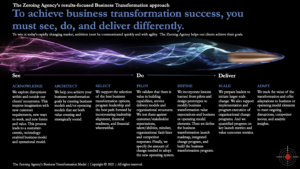The Point: Congratulations on your Business Transformation initiative! You’ve gotten yourself/your organization as a leader to the point where you are taking the steps towards changing how you conduct business — No small feat in and of itself. However, beginning the business transformation initiative is just that — the beginning. What follows will be the architecture of the strategy that falls in alignment with organizational goals, the implementation, and ultimately the monitoring of progress. This post is all about those final stages for business transformation success where you want to sustain momentum. Herein we’ll provide 5 tips to sustaining business transformation momentum… Enjoy!
Attend Webinars & Workshops – View our upcoming Webinars & Workshops
Sustaining Business Transformation Momentum
It may seem obvious that sustaining business transformation is important, and the actions necessary to do so are simple. They are not. This is because companies are often too focused on short-term gains and neglect the long-term imperative. They overlook the difficulties of breaking old habits and creating a healthy, new approach that can be implemented in thousands of daily actions instead of being referred to by a checklist. To maintain business transformation momentum, you will need to develop new skills, be disciplined, and have strong relationships with your organization.
To sustain a transformation, you must embed a “business transformation engine” — A repeatable process that fundamentally alters performance rhythms and decision-making in the company. It’s not about making strategic decisions, but rather about implementing daily initiatives that will change the way the organization works.
Looking to Transform Your Business?
Download Your 37 page | 128 question Business Transformation Self-Assessment Workbook!
There are five tips business transformation can be built, according to us:
1. See the World from a Different Perspective
It is exhausting to challenge everything, but companies that are open to change never settle for the status quo. They are open to new facts and not content with the status quo. They are vigilant against accepting easily accepted targets.
2. Think Like an Investor (Especially if You are a Private Equity Firm)
Although this mindset isn’t always popular within organizations, it is something that every leader should adopt. Passive employees can kill change in a company, as we all know. Successful employees are constantly challenging their colleagues and not content on just getting along. They don’t settle for a slow pace of decision-making either. They are always looking for new sources of value and how they can contribute to the organization.
3. Assure Ownership is On the Line
Management and outside advisors will have a tendency to set targets during a transformation program. This is what happened with a technology firm client. This should be avoided. Companies with large central teams who have centrally imposed initiatives embedded in budgets without manager buy-in are at greatest risk of falling back to their old ways.
4. Always Work Hard
Companies can easily allow their pace to slow down once they have achieved their initial improvement targets. It is easier to delegate. Senior executives who are unable to focus on high-level targets and don’t get lost in the details, perhaps under the pretext of not wanting to micromanage, should be notified.
5. Address the Underlying Mindsets
In our experience, motivated employees are more productive than those who live in a command-and-control culture. Managers must not only challenge, but instill meaning. Managers must be able to recognize the value of extra effort. They should not assume that employees understand why the company must operate differently in the future.
SUMMARY
These five tips brought into your monthly operational meetings, annual budget discussions, daily management routines should continue to be a part of executives who sustain a business transformation. Leaders that do realize that success in business transformation is not about the scoreboard or whether the organization can deliver $100m, $500m, or both. It’s about whether the process of business transformation has been repeated and replicated in a way that drives better results for the organization long after it is finished.
Sam Palazzolo





